
Atmospheric entry is the movement of an object from outer space into and through the gases of an atmosphere of a planet, dwarf planet, or natural satellite. There are two main types of atmospheric entry: uncontrolled entry, such as the entry of astronomical objects, space debris, or bolides; and controlled entry of a spacecraft capable of being navigated or following a predetermined course. Technologies and procedures allowing the controlled atmospheric entry, descent, and landing of spacecraft are collectively termed as EDL.

STS-7 was NASA's seventh Space Shuttle mission, and the second mission for the Space Shuttle Challenger. During the mission, Challenger deployed several satellites into orbit. The shuttle launched from Kennedy Space Center on June 18, 1983, and landed at Edwards Air Force Base on June 24, 1983. STS-7 carried Sally Ride, America's first female astronaut.
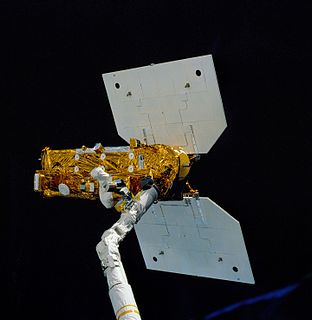
STS-41-G was the 13th flight of NASA's Space Shuttle program and the sixth flight of Space Shuttle Challenger. Challenger launched on 5 October 1984, and conducted the second shuttle landing at Kennedy Space Center on 13 October 1984. It was the first shuttle mission to carry a crew of seven, including the first crew with two women, the first American Extravehicular activity (EVA) involving a woman (Sullivan), the first Australian-born person to journey into space and the first astronaut with a beard and the first Canadian astronaut.

STS-34 was a NASA Space Shuttle mission using Atlantis. It was the 31st shuttle mission overall, and the fifth flight for Atlantis. STS-34 launched from Kennedy Space Center, Florida, on 18 October 1989, and landed at Edwards Air Force Base, California, on 23 October 1989. During the mission, the Jupiter-bound Galileo probe was deployed into space.
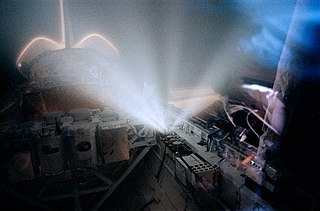
STS-39 was the twelfth mission of the NASA Space Shuttle Discovery, and the 40th orbital shuttle mission overall. The primary purpose of the mission was to conduct a variety of payload experiments for the U.S. Department of Defense (DoD).
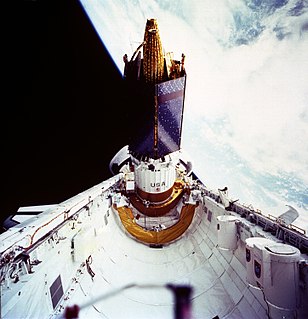
STS-43, the ninth mission for Space Shuttle Atlantis, was a nine-day mission whose primary goal was launching the TDRS-E satellite (TDRS-5). The flight also tested an advanced heatpipe radiator for potential use on the then-future space station and conducted a variety of medical and materials science investigations.

STS-51 was a NASA Space Shuttle Discovery mission that launched the Advanced Communications Technology Satellite (ACTS) in September 1993. The flight also featured the deployment and retrieval of the SPAS-ORFEUS satellite and its IMAX camera, which captured spectacular footage of Discovery in space. A spacewalk was also performed during the mission to evaluate tools and techniques for the STS-61 Hubble Space Telescope (HST) servicing mission later that year. STS-51 was the first shuttle mission to fly a Global Positioning System (GPS) receiver, a Trimble TANS Quadrex. It was mounted in an overhead window where limited field of view (FoV) and signal attenuation from the glass severely impacted receiver performance. Full triple-redundant 3-string GPS would not happen until 14 years later with STS-118 in 2007.
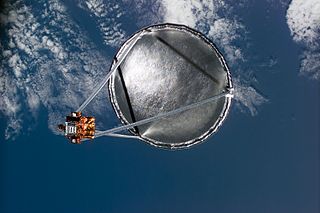
STS-77 was the 77th Space Shuttle mission and the 11th mission of the Space Shuttle Endeavour. The mission began from launch pad 39B from Kennedy Space Center, Florida on 19 May 1996 lasting 10 days and 40 minutes and completing 161 revolutions before landing on runway 33.

STS-96 was a Space Shuttle mission to the International Space Station (ISS) flown by Space Shuttle Discovery, and the first shuttle flight to dock at the International Space Station. The shuttle carried the Spacehab module in the payload, filled with cargo for station outfitting. STS-96 launched from Kennedy Space Center, Florida, on 27 May 1999 at 06:49:42 AM EDT and returned to Kennedy on 6 June 1999, 2:02:43 AM EDT.

Cascade, Smallsat and Ionospheric Polar Explorer (CASSIOPE), is a Canadian Space Agency (CSA) multi-mission satellite operated by the University of Calgary. The mission development and operations from launch to February 2018 was funded through CSA and the Technology Partnerships Canada program. In February, 2018 CASSIOPE became part of the European Space Agency's Swarm constellation through the Third Party Mission Program, known as Swarm Echo, or Swarm-E. It was launched September 29, 2013, on the first flight of the SpaceX Falcon 9 v1.1 launch vehicle. CASSIOPE is the first Canadian hybrid satellite to carry a dual mission in the fields of telecommunications and scientific research. The main objectives are to gather information to better understand the science of space weather, while verifying high-speed communications concepts through the use of advanced space technologies.

Project Echo was the first passive communications satellite experiment. Each of the two American spacecraft, launched in 1960 and 1964, were metalized balloon satellites acting as passive reflectors of microwave signals. Communication signals were transmitted from one location on Earth and bounced off the surface of the satellite to another Earth location.
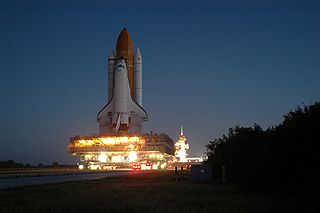
STS-116 was a Space Shuttle mission to the International Space Station (ISS) flown by Space Shuttle Discovery. Discovery lifted off on 9 December 2006 at 20:47:35 EST. A previous launch attempt on 7 December had been canceled due to cloud cover. It was the first night launch of a Space Shuttle since STS-113 in November 2002.

STS-127 was a NASA Space Shuttle mission to the International Space Station (ISS). It was the twenty-third flight of Space ShuttleEndeavour. The primary purpose of the STS-127 mission was to deliver and install the final two components of the Japanese Experiment Module: the Exposed Facility, and the Exposed Section of the Experiment Logistics Module (ELM-ES). When Endeavour docked with the ISS on this mission in July 2009, it set a record for the most humans in space at the same time in the same vehicle, the first time thirteen people have been at the station at the same time. Together they represented all ISS program partners and tied the general record of thirteen people in space with the first such occurrence of 1995.
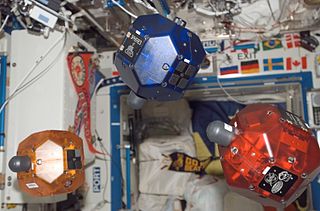
The Synchronized Position Hold Engage and Reorient Experimental Satellite (SPHERES) are a series of miniaturized satellites developed by MIT's Space Systems Laboratory for NASA and US Military, to be used as a low-risk, extensible test bed for the development of metrology, formation flight, rendezvous, docking and autonomy algorithms that are critical for future space missions that use distributed spacecraft architecture, such as Terrestrial Planet Finder and Orbital Express.
The Intelsat VI series of satellites were the 8th generation of geostationary communications satellites for the Intelsat Corporation. Designed and built by Hughes Aircraft Company (HAC) in 1983-1991, there were five VI-series satellites built: 601, 602, 603, 604, and 605.

DRAGONSat is a pair of nanosatellites that will be demonstrating autonomous rendezvous and docking (ARD) in low Earth orbit (LEO) for NASA. It will be gathering flight data with a global positioning system (GPS) receiver strictly designed for space applications to gather flight data in the space environment. ARD is the capability of two independent spacecraft to rendezvous in orbit and dock without crew intervention. One DRAGONSat was built by the University of Texas and the other one was built by Texas A and M University, the Space Shuttle Payload Launcher (SSPL), These satellite projects will rendezvous and dock with each other in space without the benefit of human intervention.

Explorer 9, known as S-56A before launch, was a NASA satellite which was launched in February 1961 to study the density and composition of the upper thermosphere and lower exosphere. It was a reflight of the failed Explorer S-56 mission, and consisted of a 7 kg (15 lb), 3.66 m (12.0 ft) balloon which was deployed into a medium Earth orbit. The mission was conducted by NASA's Langley Research Center.

Fast, Affordable, Science and Technology Satellite-Huntsville 01 or FASTSAT-Huntsville 01 of the NASA. FASTSAT-HSV 01 was flying on the STP-S26 mission - a joint activity between NASA and the U.S. Department of Defense Space Test Program, or DoD STP. FASTSAT and all of its six experiments flying on the STP-S26 multi-spacecraft/payload mission have been approved by the Department of Defense Space and Experiments Review Board (USA-220).

PSSC-2, or Pico-Satellite Solar Cell Testbed 2, also known as PSSC-Testbed 2, is a miniaturised satellite which was operated by the United States Air Force as part of a technology demonstration programme. It was the last satellite to be deployed from a Space Shuttle.

Explorer 19,, was a NASA satellite launched on 19 December 1963, as part of the Explorer program. It was the third of six identical Explorer satellites launched to study air density and composition, and the second to reach orbit. It was identical to Explorer 9.




















